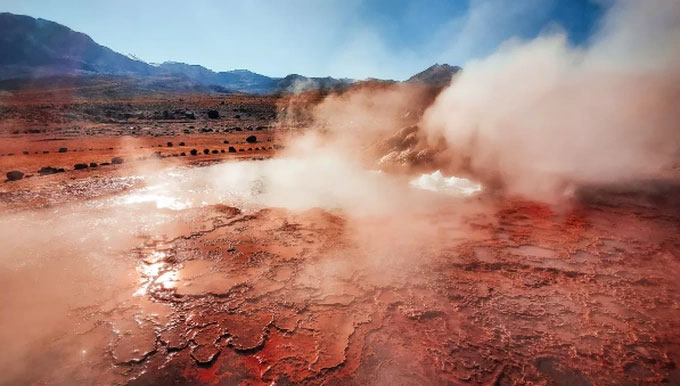A study has debunked a theory once seen as the origin of the formation of the Earth’s continents .
The Earth formed billions of years ago, but the reality is that we know very little about this process, including the division of the continents and oceans of the Blue Planet.

The El Tatio geyser located in Chile’s Atacama desert is a simulation showing how continent formation may have taken place (Image: Getty Images).
Previously, we thought that the Earth’s crust, or the outer crust of the planet, was divided into two categories, including: Older, thicker continental crust ; and younger, denser oceanic crust .
The difference between these two layers is the lack of iron element in the continental crust . This makes the continental crust lighter, and they rise above sea level to form dry land masses that make terrestrial life possible.
For a long time, scientists have hypothesized that garnet crystallization in the magma beneath the volcano is responsible for this whole process.
However, a study has challenged proponents of this hypothesis, and forced planetary scientists to rethink how the Earth came to be.

The cross section shows the different layers that make up the Earth. (Image: Getty Images).
With the goal of testing the correctness of the garnet crystallization theory , a team from the Smithsonian Institution’s High Pressure Laboratory and Cornell University (USA) recreated the high pressure and heat found beneath the rocks. volcanoes using piston cylinder presses located in laboratories.
These pistons are about the size of a mini fridge and are made of steel and tungsten carbide. They can exert great pressure on small rock samples by being heated by a cylindrical furnace around them.
According to the team, the pressure from the experiment was equivalent to 15,000 to 30,000 times the pressure produced by Earth’s atmosphere, with the heat generated being between 950 and 1,230 degrees Celsius, hot enough to melt rock. . Therefore, it is fully qualified to simulate what has been and is happening below the Earth’s crust.
Along with that, the product of this process produces artificial rubies, like the garnet crystallization that happened in volcanic magma.
However, what is surprising is that the whole process takes place without enough iron absorption, as well as without oxidation as previously hypothesized. In other words, previous theories about the formation of the Earth’s continent may have been completely wrong.
“This result makes the hypothesis of a garnet crystallization model extremely unlikely under real-world conditions,” said geologist Elizabeth Cottrell, who also led the study.
The geologist further explained that this result does not currently provide an alternative hypothesis to explain the formation of the continental crust. In other words, the study raised more questions than it answered.
“What’s accelerating the oxidation or depleting the iron? What’s going on inside the mantle?” Cottrell asked the question.

